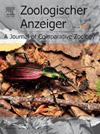Low genetic diversity and future challenges for the Caspian bent-toed gecko (Tenuidactylus caspius) in a changing climate
IF 1.5
3区 生物学
Q2 ZOOLOGY
引用次数: 0
Abstract
Climate change significantly impacts species distributions and adaptability. This study investigates the evolutionary history, genetic variation, and potential distribution shifts of the Caspian bent-toed gecko (Tenuidactylus caspius) in Iran under past, present, and future climate conditions. Phylogenetic analysis revealed two distinct subclades within T. caspius, which diverged approximately 1.14 million years ago. Despite this divergence, distinct subclades were not observed in terms of notable differentiation, as the species showed low genetic diversity, with only nine haplotypes and limited nucleotide variation. Population size remained relatively constant over time, with a slight recent decline. Biogeographic analysis indicated a complex history of dispersal and vicariance events. Species distribution modeling suggests a historically wider range, with a northward expansion during the Last Glacial Maximum. The current range is reduced, and future projections (2061–2080) indicate a further decline, especially in marginal areas, with the eastern range becoming the core habitat. The low genetic diversity raises concerns about the species' adaptability to climate change. Conservation efforts should focus on protecting existing populations, particularly in the eastern range, and maintaining habitat connectivity to support gene flow. This study highlights the importance of integrating genetic and historical data for effective conservation planning in the context of climate change.
气候变化下里海弯趾壁虎遗传多样性低及未来面临的挑战
气候变化显著影响物种的分布和适应性。本研究调查了过去、现在和未来气候条件下伊朗里海弯趾壁虎(Tenuidactylus caspius)的进化史、遗传变异和潜在分布变化。系统发育分析显示,在大约114万年前,caspius有两个不同的亚分支。尽管存在这种差异,但由于物种表现出较低的遗传多样性,只有9个单倍型和有限的核苷酸变异,因此没有观察到明显的分化。随着时间的推移,人口规模保持相对稳定,最近略有下降。生物地理分析表明其具有复杂的扩散和变异历史。物种分布模型表明,在末次盛冰期,物种向北扩展,其历史范围更广。目前的范围缩小了,未来预测(2061-2080)表明进一步下降,特别是在边缘地区,东部范围成为核心栖息地。低遗传多样性引发了人们对该物种对气候变化适应性的担忧。保护工作应侧重于保护现有种群,特别是在东部地区,并保持栖息地的连通性,以支持基因流动。该研究强调了在气候变化背景下整合遗传和历史数据对有效保护规划的重要性。
本文章由计算机程序翻译,如有差异,请以英文原文为准。
求助全文
约1分钟内获得全文
求助全文
来源期刊

Zoologischer Anzeiger
生物-动物学
CiteScore
2.80
自引率
7.10%
发文量
75
审稿时长
>12 weeks
期刊介绍:
Zoologischer Anzeiger - A Journal of Comparative Zoology is devoted to comparative zoology with a special emphasis on morphology, systematics, biogeography, and evolutionary biology targeting all metazoans, both modern and extinct. We also consider taxonomic submissions addressing a broader systematic and/or evolutionary context. The overall aim of the journal is to contribute to our understanding of the organismic world from an evolutionary perspective.
The journal Zoologischer Anzeiger invites suggestions for special issues. Interested parties may contact one of the editors.
 求助内容:
求助内容: 应助结果提醒方式:
应助结果提醒方式:


